 W
WThe Battle of 73 Easting was fought on 26 February 1991, during the Persian Gulf War, between the armoured forces of the United States as well as the 1st Armoured Division of the United Kingdom and those of the Iraqi Republican Guard and its Tawakalna Division. It was named for a UTM north-south coordinate line in the featureless desert that was used as a phase line to measure progress of the offensive as they were going through what the Iraqis thought was trackless desert. The battle was later described by Lt. John Mecca, who participated in the battle, as "the last great tank battle of the 20th century." This battle took place several hours after another, smaller, tank battle known as the Battle of Al Busayyah.
 W
WThe 1991 bombing of Israel was a bombing campaign on Israel from 17 January to 28 February 1991, by Iraq in an unsuccessful bid to provoke Israeli retaliation during the Gulf War.
 W
WThe Amiriyah shelter bombing was an aerial attack that killed at least 408 civilians on 13 February 1991 during the Persian Gulf War, when an air-raid shelter, in the Amiriyah neighborhood of Baghdad, Iraq, was destroyed by the U.S. Air Force with two laser-guided "smart bombs".
 W
WThe Battle of Basra was a battle fought in the beginning of the 1991 uprisings in Iraq following the Gulf War. The battle started after demoralized troops throughout Iraq began to rebel against Saddam Hussein's Ba'athist regime, in particular after a tank driver in Basra fired at a public portrait of Saddam Hussein. Basra became a chaotic battlefield between military defectors and Iraqi Republican Guard, with most of the fighting taking place at close quarters. Most of Basra had been retaken by mid March, but rebels in parts such as Tanuma managed to hold out until mid April. After Ba'athist forces had regained control, they engaged in a crackdown against civilians and suspected supporters of the uprising.
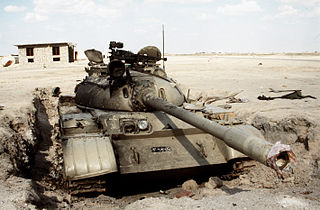 W
WThe Battle for Jalibah Airfield took place when the U.S. 2nd Brigade, 24th Infantry Division successfully attacked and captured the heavily defended Jalibah Southeast Air Base military airfield in Iraq, located 80 miles west of Basra, on February 27, 1991 during the Gulf War.
 W
WThe Battle of Medina Ridge was a tank battle fought on the 27 February 1991, during the Gulf War, between the U.S. 1st Armored Division and the 2nd Brigade of the Iraqi Republican Guard Medina Luminous Division outside Basra, Iraq. The U.S. 3rd Brigade, 3rd Infantry Division was also a major contributor, by leading the attack. Iraq's Adnan Motorized Division was also a participant. Medina Ridge is the name American troops gave to a low rise, approximately seven miles (11 km) long.
 W
WThe Battle of Norfolk was a tank battle fought on February 27, 1991, during the Persian Gulf War, between armored forces of the United States and United Kingdom, and those of the Ba'athist Iraqi Republican Guard in the Muthanna Province of southern Iraq. The primary participants were the U.S. 2nd Armored Division (Forward),1st Infantry Division (Mechanized), and the Iraqi 18th Mechanized and 9th Armoured Brigades of the Republican Guard Tawakalna Mechanized Infantry Division along with elements from eleven other Iraqi divisions. The 2nd Armored Division(Fwd) was assigned to the American 1st Infantry Division as its 3rd maneuver brigade due to the fact that one of its brigades was not deployed. The 2nd Armored Division(Fwd)'s Task Force 1-41 Infantry would be the spearhead of VII Corps. The British 1st Armoured division was responsible for protecting the right flank of VII Corps, their main adversary being the Iraqi 52nd Armored Division and multiple infantry divisions. It was the final battle of the war before the unilateral ceasefire took effect. One more battle occurred near the oil field at Rumaila after the ceasefire.
 W
WThe Battle of Phase Line Bullet was one of a series of clashes which led to the destruction of the Tawakalna Iraqi Republican Guard Division, on the 26 February 1991, by a simultaneous attack of the 1st and 3rd armoured divisions, the 1st Infantry Division, and the 2nd Armoured Cavalry Regiment.
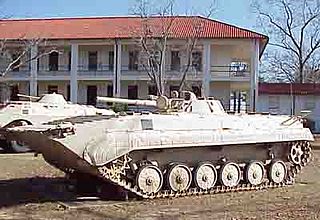 W
WThe Battle of Rumaila, also known as the Battle of the Causeway or the Battle of the Junkyard, was a controversial attack that took place on March 2, 1991, two days after President Bush declared a ceasefire, near the Rumaila oil field in the Euphrates Valley of southern Iraq, when the U.S. Army forces, mostly the 24th Infantry Division under Major General Barry McCaffrey engaged and nearly annihilated a large column of withdrawing Iraqi Republican Guard armored forces during the immediate aftermath of the Gulf War.
 W
WThe Gulf War was a war waged by coalition forces from 35 nations led by the United States against Iraq in response to Iraq's invasion and annexation of Kuwait arising from oil pricing and production disputes. It was codenamed Operation Desert Shield for operations leading to the buildup of troops and defense of Saudi Arabia and Operation Desert Storm in its combat phase.
 W
WThe Battle of Karbala was a battle fought during the 1991 uprisings in Iraq following the Gulf War. The battle started after demoralized troops throughout Iraq began to rebel against Saddam Hussein. From 5 to 19 March 1991, the city of Karbala became a chaotic battlefield between the insurgents and the Iraqi Republican Guard. After the failure of the uprising, citizens were killed in large numbers. Parts of the city were nearly leveled.
 W
WThe Battle of Kirkuk was one of the biggest battles of the 1991 uprisings in Iraq.
 W
WThe Package Q Airstrike was the largest airstrike of the Persian Gulf War, and the largest strike of F-16s in military history. Many aircraft including the F-117 were used to attack targets in Baghdad, which was the most heavily defended area of Iraq. The same target was hit several times by F-117, and the last package consisted of seventeen F-111F on the 19th day of the war.
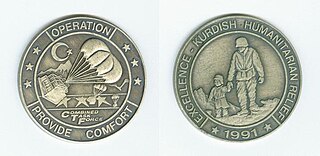 W
WOperation Provide Comfort and Provide Comfort II were military operations initiated by the United States and other Coalition nations of the Persian Gulf War, starting in April 1991, to defend Kurdish refugees fleeing their homes in northern Iraq in the aftermath of the Gulf War, and to deliver humanitarian aid to them. The no-fly zone instituted to help bring this about would become one of the main factors allowing the development of the autonomous Kurdistan Region.
 W
WThe Battle of Saddam City occurred in March 1991 as part of the wider anti-Saddam uprisings across Iraq, although the uprising in the Saddam City district of Baghdad was far more limited in scale that the kind of uprisings seen in southern Iraq. In response to the unrest in Saddam City, Saddam Hussein's son Qusay Hussein led a siege of the district, with dissent being repressed. Baghdad as a whole remained quiet, with the capital serving not as a center for the uprisings, but as a staging-post for the government counter-offensive.
 W
WThe Safwan Airfield standoff was a post-ceasefire standoff between the Iraqi and U.S. forces at the end of the 1991 Gulf War.
 W
WThe Battle of Tuz Khormato refers to the a battle fought during the 1991 uprisings in Iraq between the Peshmerga and Iraqi forces. Tuz Khormatu, a predominantly Turkmen town, was one of the most southernly towns to fall under the control of the Peshmerga.
 W
WUnited Nations Security Council resolution 685, adopted unanimously on 31 January 1991, after recalling resolutions 598 (1987), 618 (1988), 631 (1989), 642 (1989), 651 (1990), 671 (1990) and 676 (1990), and having considered a report by the Secretary-General Javier Pérez de Cuéllar on the United Nations Iran–Iraq Military Observer Group, the Council decided:(a) to renew the mandate of the United Nations Iran–Iraq Military Observer Group for one more month until 28 February 1991; (b) to request the Secretary-General, after discussions with both parties, to report on the future of the Observer Group with his recommendations during February 1991.
 W
WUnited Nations Security Council resolution 686, adopted on 2 March 1991, after reaffirming resolutions 660, 661, 662, 664, 665, 666, 667, 669, 670, 674, 677 and 678, the Council noted the suspension of military activities against Iraq and that all twelve resolutions continue to have full force and effect.
 W
WUnited Nations Security Council Resolution 687, adopted on 3 April 1991, after reaffirming resolutions 660, 661, 662, 664, 665, 666, 667, 669, 670, 674, 677, 678 and 686 (1991), the Council set the terms, in a comprehensive resolution, with which Iraq was to comply after losing the Gulf War. Resolution 687 was passed by 12 votes to one against (Cuba) with two abstentions from Ecuador and Yemen after a very extended meeting. Iraq accepted the provisions of the resolution on 6 April 1991.
 W
WUnited Nations Security Council Resolution 688, adopted on 5 April 1991, after receiving letters from the representatives of France, Iran, and Turkey and expressing its concern over political repression of the Iraqi people, including those in Iraqi Kurdistan, the Council condemned the repression and demanded that Iraq, as a contribution to removing the threat to international peace and security, end the repression and respect the human rights of its population.
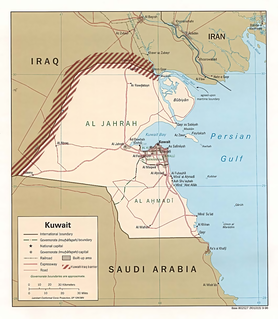 W
WUnited Nations Security Council resolution 689, adopted unanimously on 9 April 1991, after recalling Resolution 687 (1991), the Council noted a report by the Secretary-General and decided to establish the United Nations Iraq–Kuwait Observation Mission to monitor the demilitarized zone between Iraq and Kuwait, known as the Kuwait–Iraq barrier.
 W
WUnited Nations Security Council resolution 692, adopted on 20 May 1991, after recalling resolutions 674 (1990), 686 (1991) and 687 (1991), as well as taking the report by the Secretary-General, the Council decided to establish the United Nations Compensation Commission to deal with compensation claims resulting from Iraq's invasion of Kuwait, which subsequently led to the Gulf War.
 W
WUnited Nations Security Council resolution 699, adopted unanimously on 17 June 1991, after recalling Resolution 687 (1991) and noting the report by the Secretary-General it requested, the Council, acting under Chapter VII, confirmed that the International Atomic Energy Agency and United Nations Special Commission have the authority to undertake weapons inspections in Iraq and to remove, destruct or render the weapons harmless.
 W
WUnited Nations Security Council resolution 700, adopted unanimously on 17 June 1991, after recalling resolutions 661 (1991), 665 (1991), 670 (1991) and 687 (1991), and noting the report by the Secretary-General it requested, the Council, acting under Chapter VII, the Council approved the full implementation of Resolution 687–the arms embargo against Iraq.
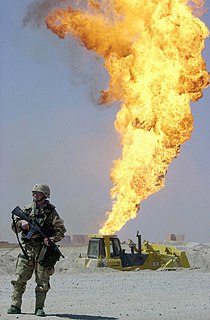 W
WUnited Nations Security Council resolution 706 decided on a mechanism to allow Iraq to sell oil in return for humanitarian aid from Member States. The Council, acting under Chapter VII, adopted the resolution on 15 August 1991, after recalling resolutions 661 (1990), 686 (1991), 687 (1991), 688 (1991), 692 (1991), 699 (1991) and 705 (1991). The provisions of Resolution 706 functioned in a way similar to that which was later implemented in the Oil-for-Food Programme under Resolution 986 in 1995.
 W
WUnited Nations Security Council resolution 707, adopted unanimously on 15 August 1991, after recalling Resolution 687 (1991) and hearing representations from the International Atomic Energy Agency (IAEA) and United Nations Special Commission, the Council, acting under Chapter VII, condemned Iraq for violations and non-compliance of Resolution 687 (1991) and extended powers to the Special Commission and IAEA.
 W
WUnited Nations Security Council resolution 712, adopted on 19 September 1991, after recalling resolutions 661 (1990), 686 (1991), 687 (1991), 688 (1991), 692 (1991), 699 (1991), 705 (1991) and 706 (1991), the Council, acting under Chapter VII, reaffirmed and discussed provisions of Resolution 706 and called for international co-operation.
 W
WUnited Nations Security Council resolution 715, adopted unanimously on 11 October 1991, after recalling resolutions 687 (1991) and 707 (1991), the Council, acting under Chapter VII of the United Nations Charter, approved plans from the International Atomic Energy Agency (IAEA) and Secretary-General Javier Pérez de Cuéllar regarding the long-term monitoring of Iraq's weapons programme, requiring it to submit "on-going monitoring and verification" of the country's dual-use facilities.
 W
WThe Battle of Sulaymaniyah was one of the biggest battles fought during the 1991 uprisings in Iraq. Sulaymaniyah, a Kurdish city with a population of over 100,000, was the first Iraqi city to be captured by rebels and the last one to fall. The city was recaptured by Kurdish rebels, after the Peshmerga launched a new offensive on 20 July.
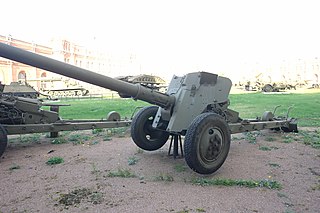 W
WThe Battle of Wadi Al-Batin or Battle of Ruqi Pocket took place before the beginning of the Desert Storm operations on 16 February 1991. This is not to be confused with the "Battle of Wadi Al-Batin" which was fought later in the four-day ground war between elements of the U.S. 3rd Armored Division and the Iraqi Republican Guard.